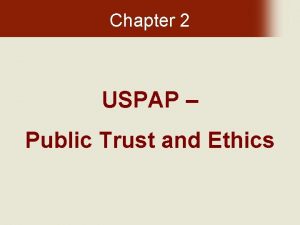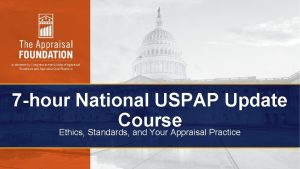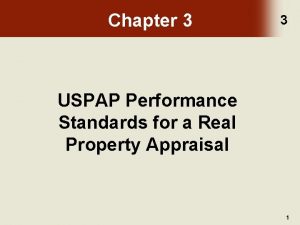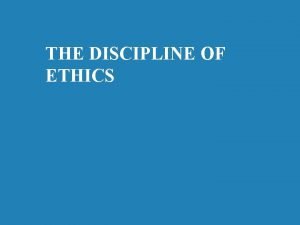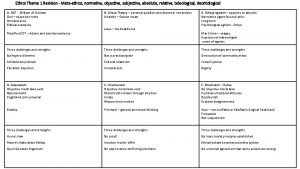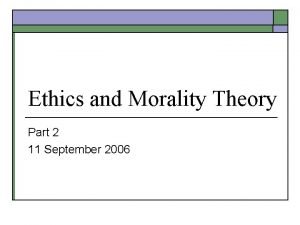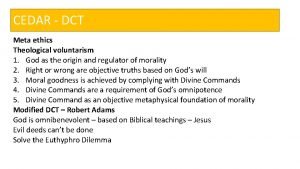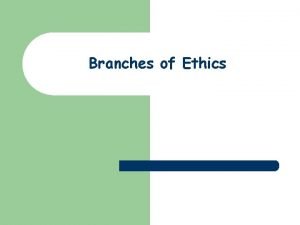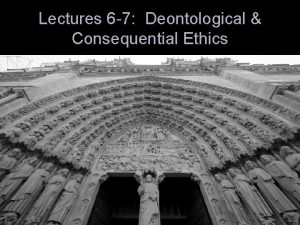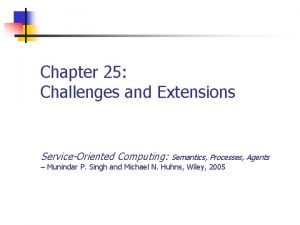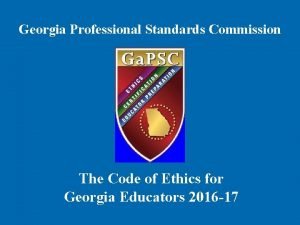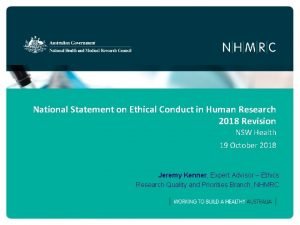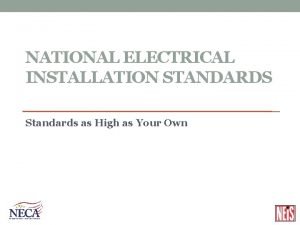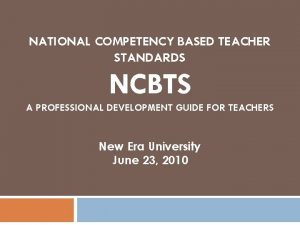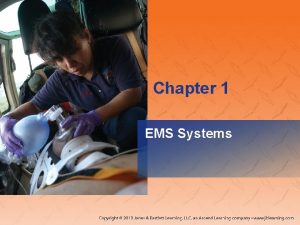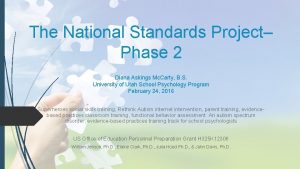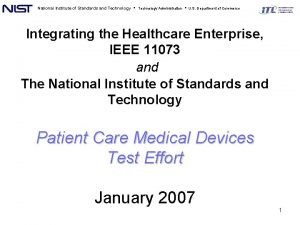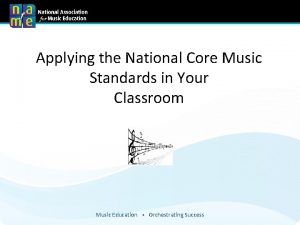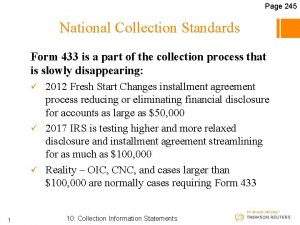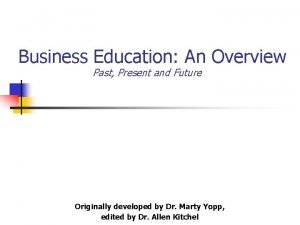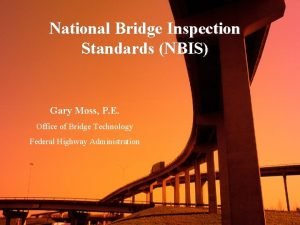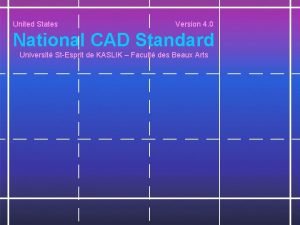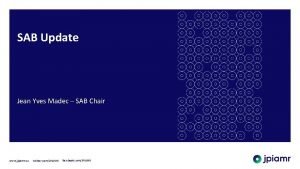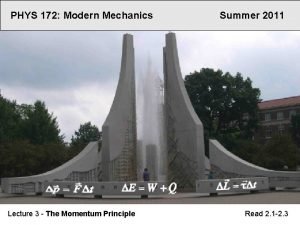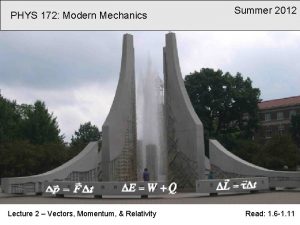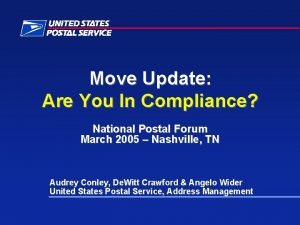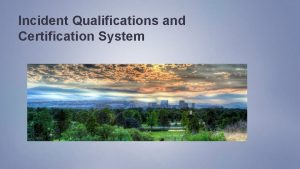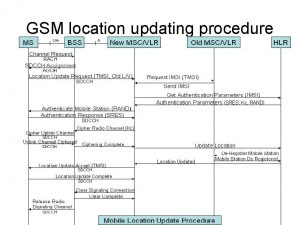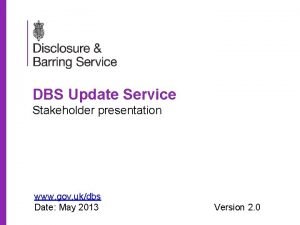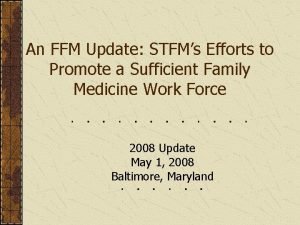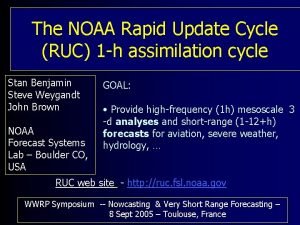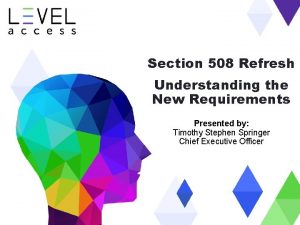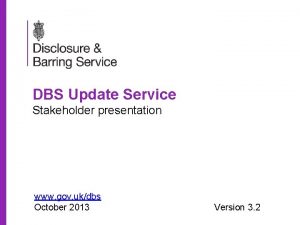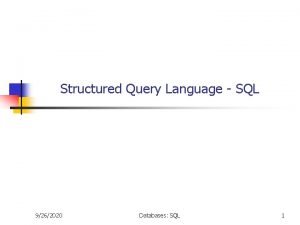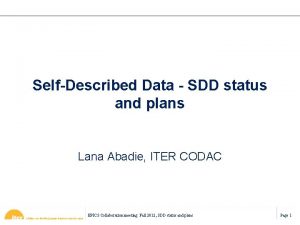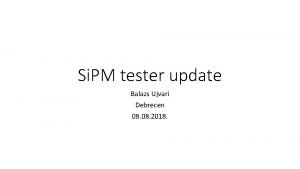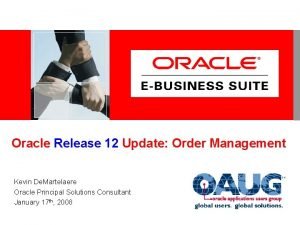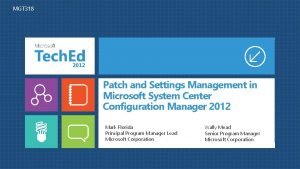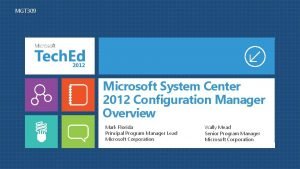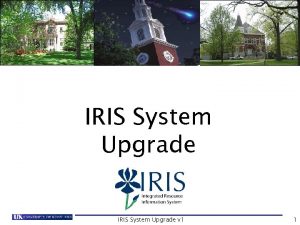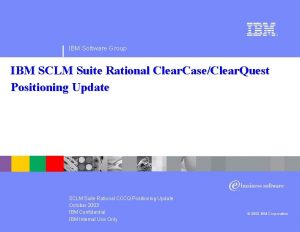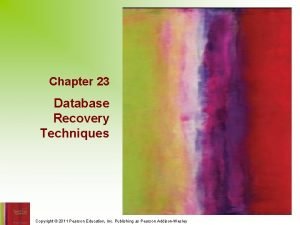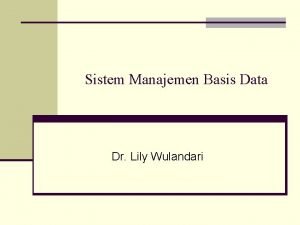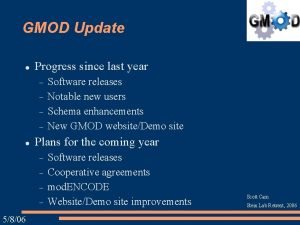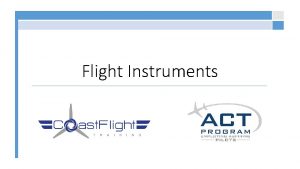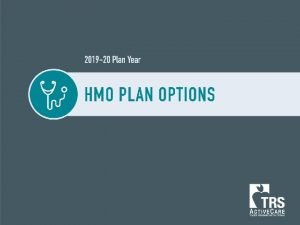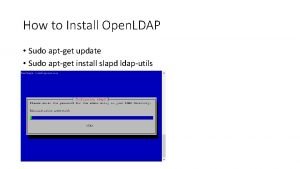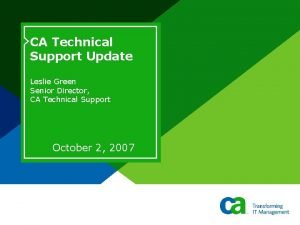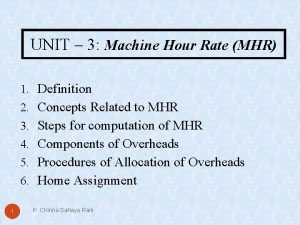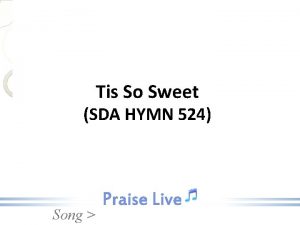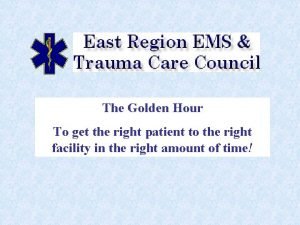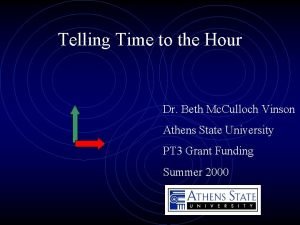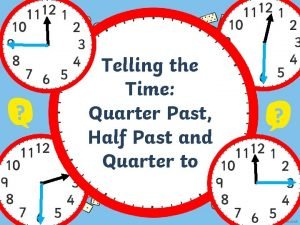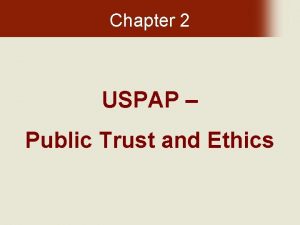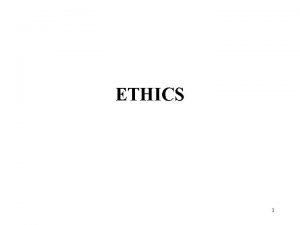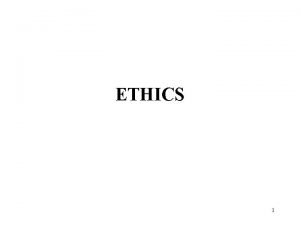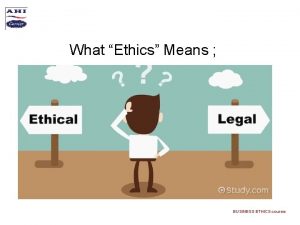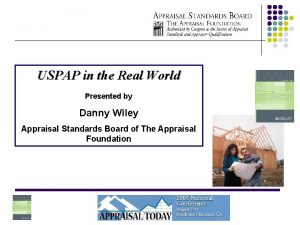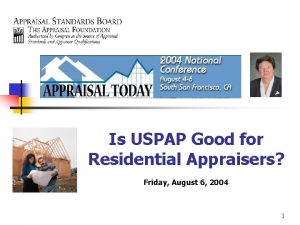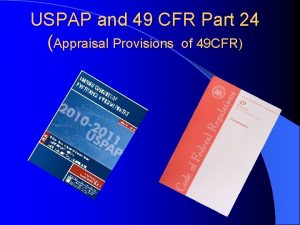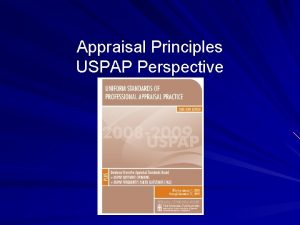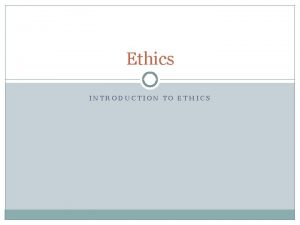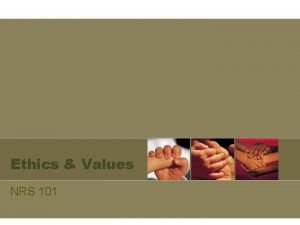7 hour National USPAP Update Course Ethics Standards

































































































































































- Slides: 161

7 -hour National USPAP Update Course Ethics, Standards, and Your Appraisal Practice

7 -Hour National Uniform Standards of Professional Appraisal Practice (USPAP) Update Course - Ethics, Standards, and Your Appraisal Practice Slide #2

PREVIEW – Course Design • Course incorporates use of the 2020 -2021 USPAP publication. • “From Your Perspective” exercises are intended to illustrate applications of USPAP. • “Back to Basics” segments are provided to help keep things in context. © 2020 The Appraisal Foundation Slide #3

PREVIEW – Course Materials • Student Manual • USPAP Publication, which includes: 1. USPAP 2. Advisory Opinions (AOs) 3. Frequently Asked Questions (FAQs) 4. Index © 2020 The Appraisal Foundation Slide #4

Page ii PREVIEW – Course Objectives • Present and explain revisions to USPAP effective from January 1, 2020 through December 31, 2021 • Present changes to USPAP in a variety of scenarios for class discussion • Present scenarios that challenge participants to apply USPAP. © 2020 The Appraisal Foundation Slide #5

Page iii PREVIEW – Classroom Guidelines • No smoking • Silence electronic devices • Audio/video recording is prohibited • Be considerate of those seated near you © 2020 The Appraisal Foundation Slide #6

Page iii PREVIEW – Announcements • Break times and lunch • Restroom locations • Attendance sheets • Course certificates © 2020 The Appraisal Foundation Slide #7

INTRODUCTIONS – Instructor <Instructor name> <phone> <email> <any other pertinent information> © 2020 The Appraisal Foundation Slide #8

Page 1 INTRODUCTION – Before We Begin … • “The purpose of the Uniform Standards of Professional Appraisal Practice (USPAP) is …” Who or what public? Why? © 2020 The Appraisal Foundation Slide #9

Page 1 INTRODUCTION – Before We Begin … • “The purpose of the Uniform Standards of Professional Appraisal Practice (USPAP) is …” … the need for public to be able to have confidence … The public … exists on several levels … See FAQ 9. © 2020 The Appraisal Foundation Slide #10

SECTION ONE LEARNING FOCUS: Changes to USPAP Changes to the Advisory Opinions Slide #11

Changes to USPAP and the Advisory Opinions Page 3 • Umbrella of public trust is of paramount importance to the ASB • Process is transparent and encourages input for interested parties © 2020 The Appraisal Foundation Slide #12

Page 4 BACK TO BASICS #1 • What is in the “USPAP Publication” – USPAP – Advisory Opinions (AOs) – Frequently Asked Questions (FAQs) – Index • These Back to Basics are mini discussions to help keep the material in context © 2020 The Appraisal Foundation Slide #13

Page 4 Why and How Changes are Made • Most changes are started by issues raised by stakeholders • Stakeholders include: – Appraisers – Appraisal clients – Government agencies – Others © 2020 The Appraisal Foundation Slide #14

Pages 4 -5 Why and How Changes are Made • ASB writes and releases exposure drafts • ASB receives, reads and considers all comments to the exposure drafts • ASB may issue subsequent exposure drafts based on the input from stakeholders © 2020 The Appraisal Foundation Slide #15

Page 5 Why and How Changes are Made • Four exposure drafts were issued for the 2020 -2021 edition • Adoption can only be made after the exposure process and only in a public meeting • Once adopted, only administrative edits may be made to USPAP © 2020 The Appraisal Foundation Slide #16

Page 6 BACK TO BASICS #2 • Credible vs Not Misleading – what is the difference? • Credible is an objective of the development process (e. g. , credible assignment results) • Not misleading is an objective of reporting (i. e. , communicated results in a manner that is not misleading) © 2020 The Appraisal Foundation Slide #17

Changes and Additions to the Definitions Page 6 • Added language to explain the purpose of defining terms in USPAP: Defined terms are intended to … © 2020 The Appraisal Foundation Slide #18

Changes and Additions to the Definitions Page 7 • Many of the changes moved important elements of Definitions out of Comments and into the main text of the Definition. • Other edits made for clarity or to make the Definition consistent with current practice. © 2020 The Appraisal Foundation Slide #19

Changes and Additions to the Definitions Page 7 • Minor edits were made to remove Comments from the following Definitions: – Appraisal Review – Assignment Results – Client – Cost – Exposure Time – Valuation Service (was valuation services) © 2020 The Appraisal Foundation Slide #20

Changes and Additions to the Definitions Page 7 • Example of edit to remove a Comment: CLIENT: the party or parties (i. e. , individual, group, or entity) who engage, by employment or contract, an appraiser by employment or contract in a specific assignment, whether directly or through an agent. Comment: The client may be an individual, group, or entity, and may engage and communicate with the appraiser directly or through an agent. © 2020 The Appraisal Foundation Slide #21

Changes and Additions to the Definitions Pages 7 -8 • Minor edits were made to the following Definitions without removing Comments: – Appraisal Practice – Market Value – Value © 2020 The Appraisal Foundation Slide #22

Changes and Additions to the Definitions Page 8 • In two cases, Comments were removed and no other edits were made: – Assignment Conditions – Real Property © 2020 The Appraisal Foundation Slide #23

Changes and Additions to the Definitions Page 8 • In the case of one minor edit, only the main text of the definition was edited: – Workfile © 2020 The Appraisal Foundation Slide #24

Changes and Additions to the Definitions Page 8 • Two Definitions received significant revision: – Appraiser – Personal Property © 2020 The Appraisal Foundation Slide #25

Changes and Additions to the Definitions Page 8 • Major revision was made to the Definition of Appraiser: – The Comment which (per PREAMBLE) provides interpretation and established the context and conditions for application has been removed. © 2020 The Appraisal Foundation Slide #26

Changes and Additions to the Definitions Page 8 Change to the Definition of Appraiser: – APPRAISER: one who is expected to perform valuation services competently and in a manner that is independent, impartial, and objective. Comment: Such expectation occurs when individuals, either by choice or by requirement placed upon them or upon the service they provide by law, regulation, or agreement with the client or intended users, represent that they comply. © 2020 The Appraisal Foundation Slide #27

Changes and Additions to the Definitions Page 8 • Major revision was made to the Definition of Personal Property: – In today’s environment with virtual and/or digital objects, etc. intangible items should rightly be considered personal property. The prior definition limited personal property to tangible items. – Edit brings term in line with current practice © 2020 The Appraisal Foundation Slide #28

Changes and Additions to the Definitions Change to the Definition of Personal Property: Pages 8 -9 • PERSONAL PROPERTY: identifiable tangible objects that are considered by the general public as being “personal” - for example, furnishings, artwork, antiques, gems and jewelry, collectibles, machinery and equipment; all tangible property that is not classified as real estate. Any tangible or intangible article that is subject to ownership and not classified as real property, including identifiable tangible objects that are considered by the general public as being “personal, ” such as furnishings, artwork, antiques, gems and jewelry, collectibles, machinery and equipment; and intangible property that is created and stored electronically such as plans for installation art, choreography, emails, or designs for digital tokens. © 2020 The Appraisal Foundation Slide #29

Changes and Additions to the Definitions Page 9 • There are six new Definitions: – Assignment Elements – Effective Date – Misleading – Personal Inspection – Physical Characteristics – Relevant Characteristics © 2020 The Appraisal Foundation Slide #30

Changes and Additions to the Definitions Page 9 • Assignment Elements: ASSIGNMENT ELEMENTS: Specific information needed to identify the appraisal or appraisal review problem: client and any other intended users; intended use of the appraiser’s opinions and conclusions; type and definition of value; effective date of the appraiser’s opinions and conclusions; subject of the assignment and its relevant characteristics; and assignment conditions. • Although the definition is new, the elements had been listed in the SCOPE OF WORK RULE. © 2020 The Appraisal Foundation Slide #31

Changes and Additions to the Definitions Page 9 • Effective Date: EFFECTIVE DATE: the date to which an appraiser’s analyses, opinions, and conclusions apply; also referred to as date of value. • This was added because of the importance of the concept in appraisal work © 2020 The Appraisal Foundation Slide #32

Changes and Additions to the Definitions Page 9 • Misleading: MISLEADING: Intentionally or unintentionally misrepresenting, misstating, or concealing relevant facts or conclusions. • In the context in which it is used in USPAP, misleading has a meaning quite different than its meaning in law. The addition of the Definition will help minimize confusion. © 2020 The Appraisal Foundation Slide #33

Changes and Additions to the Definitions Pages 9 -10 • Personal Inspection: PERSONAL INSPECTION: a physical observation performed to assist in identifying relevant property characteristics in a valuation service. Comment: An appraiser’s inspection is typically limited to those things readily observable without the use of special testing or equipment. Appraisals of some types of property, such as gems and jewelry, may require the use of specialized equipment. An inspection by an appraiser is not the equivalent of an inspection by an inspection professional (e. g. , a structural engineer, home inspector, or art conservator). © 2020 The Appraisal Foundation Slide #34

Changes and Additions to the Definitions Page 10 • Physical Characteristics: PHYSICAL CHARACTERISTICS: attributes of a property that are observable or measurable as a matter of fact, as distinguished from opinions and conclusions, which are the result of some level of analysis or judgment. © 2020 The Appraisal Foundation Slide #35

Changes and Additions to the Definitions Page 10 • Relevant Characteristics: RELEVANT CHARACTERISTICS: features that may affect a property’s value or marketability such as legal, economic, or physical characteristics. © 2020 The Appraisal Foundation Slide #36

Page 10 Impact on Practice • Changes to Definitions should have minimal impact on appraisers • One exception might be “hybrid” assignments • Another exception may impact on some personal property assignments © 2020 The Appraisal Foundation Slide #37

Page 11 FROM YOUR PERSPECTIVE #1 • What is the difference? – Client – Intended User © 2020 The Appraisal Foundation Slide #38

Page 11 FROM YOUR PERSPECTIVE #1 • What is the difference? – Client – Intended User See FAQ 128 © 2020 The Appraisal Foundation Slide #39

Page 11 FROM YOUR PERSPECTIVE #2 • Standards Rule 1 -3 references “a market value opinion. ” • Does this exclude liquidation value assignments? © 2020 The Appraisal Foundation Slide #40

Page 11 FROM YOUR PERSPECTIVE #2 • Standards Rule 1 -3 references “a market value opinion. ” • Does this exclude liquidation value assignments? No - See the Definition of Market Value. If the liquidation value definition has all of the elements addressed in the USPAP definition of market value, it is market value for purposes of measuring USPAP compliance. © 2020 The Appraisal Foundation Slide #41

Page 12 FROM YOUR PERSPECTIVE #3 • If no interior inspection - have I violated USPAP? © 2020 The Appraisal Foundation Slide #42

Page 12 FROM YOUR PERSPECTIVE #3 • If no interior inspection - have I violated USPAP? See FAQ #190 © 2020 The Appraisal Foundation Slide #43

Page 12 BACK TO BASICS #3 • Definition of Appraiser – Not based on holding a credential – Not necessarily based on assignment type – What is the expectation (regardless of what one calls oneself)? © 2020 The Appraisal Foundation Slide #44

Changes to the SCOPE OF WORK RULE Page 13 • Rationale for revising – The Disclosure Obligations section of the Rule did not address flexibility – Appraiser has flexibility in both level of detail in a report and how the scope of work is disclosed © 2020 The Appraisal Foundation Slide #45

Changes to the SCOPE OF WORK RULE Page 13 • What changed? – Language added to the main text of the Rule – New paragraph addressing flexibility and associated responsibility was added to the Comment © 2020 The Appraisal Foundation Slide #46

Changes to the SCOPE OF WORK RULE • Impact on practice – Should not change how assignments are performed – Including concepts from reporting Standards and guidance in the SCOPE OF WORK RULE should make the requirements clearer © 2020 The Appraisal Foundation Slide #47 Page 13

Page 14 FROM YOUR PERSPECTIVE #4 • Appraiser uses a standardized form with a description of the minimum acceptable scope of work • Does that meet the requirements of Disclosure Obligations section and STANDARD 2? © 2020 The Appraisal Foundation Slide #48

Page 14 FROM YOUR PERSPECTIVE #4 • Does the language built into the form ensure compliance? Probably not. USPAP requires a disclosure of the work actually performed (and sometimes the work not performed) © 2020 The Appraisal Foundation Slide #49

Page 14 FROM YOUR PERSPECTIVE #5 • Report must disclose scope of work performed • What about work not performed? © 2020 The Appraisal Foundation Slide #50

Page 14 FROM YOUR PERSPECTIVE #5 • What about work not performed? Possibly. Exclusion of an approach must always be explained. Sometimes, the exclusion of other research and analysis may also need to be explained. See FAQ #312 © 2020 The Appraisal Foundation Slide #51

Page 15 FROM YOUR PERSPECTIVE #6 • What does “state the reasons” for the exclusion of an approach mean? – Okay to just state considered, but not developed? – Okay to just state not necessary for credible results? – If not, what is needed? © 2020 The Appraisal Foundation Slide #52

Page 15 FROM YOUR PERSPECTIVE #6 • Explaining the exclusion of approaches USPAP requires that the report state the reasons for exclusion. Why was it not developed? Why is it not necessary for credible results? See FAQ #313 © 2020 The Appraisal Foundation Slide #53

Pages 15 -16 Changes to the COMPETENCY RULE • Rationale for revising – Standards Rule 1 -1(c) stated that perfection is not required. This applies only to development – The concept should also apply to reporting; moving it to the COMPETENCY RULE accomplishes this. – A minor change was made to the Acquiring Competency section © 2020 The Appraisal Foundation Slide #54

Page 16 Changes to the COMPETENCY RULE • What changed? The rule now states (in part): Perfection is impossible to attain, and competence does not require perfection. However, an appraiser must not render appraisal services in a careless or negligent manner. This Rule requires an appraiser to use due diligence and due care. © 2020 The Appraisal Foundation Slide #55

Page 17 Changes to the COMPETENCY RULE • Minor change to the Acquiring Competency section: If an appraiser determines he or she is not competent prior to accepting agreeing to perform an assignment, the appraiser must: • This wording is more consistent with the definition of assignment. © 2020 The Appraisal Foundation Slide #56

Page 17 -18 Changes to the COMPETENCY RULE • Impact on practice – No new requirements – The changes make it clear that perfection is not required in either development or reporting © 2020 The Appraisal Foundation Slide #57

Page 18 FROM YOUR PERSPECTIVE #7 • Desk review of an appraisal of a property in another state • I am not familiar with the market in that state – Can I perform a USPAP-compliant appraisal review? © 2020 The Appraisal Foundation Slide #58

Page 18 FROM YOUR PERSPECTIVE #7 • Can I perform a USPAP-compliant appraisal review? Yes, depending on the scope of the appraisal review assignment. See FAQ #336 © 2020 The Appraisal Foundation Slide #59

Page 19 BACK TO BASICS #4 • Development includes: – Identifying, determining, analyzing, collecting, verifying, and reconciling • Reporting includes: – Disclosing, stating, summarizing, providing, and including © 2020 The Appraisal Foundation Slide #60

Changes to the Development STANDARDS Page 19 • What changed in STANDARDS 1 and 3? – Superfluous language removed – Language from 1 -1(c) and 3 -1(c) was moved to the COMPETENCY RULE © 2020 The Appraisal Foundation Slide #61

Changes to the Development STANDARDS Pages 19 -28 • What changed in STANDARDS 1 and 3? – Requirements that had been in Comments have been moved into the main text of various Standards Rules (See example in Standards Rule 1 -2 in Student Manual) – Many similar edits throughout the STANDARDS 1 and 3 © 2020 The Appraisal Foundation Slide #62

Page 29 FROM YOUR PERSPECTIVE #8 • Appraising a leased fee interest • USPAP requires analysis of effect on value of terms and conditions of lease – Must appraiser also analyze subject’s operating expense history? © 2020 The Appraisal Foundation Slide #63

Page 29 FROM YOUR PERSPECTIVE #8 • Must appraiser also analyze subject’s operating expense history? Probably not. This is a scope of work decision. Criteria for acceptable scope of work: • Expectations of those who are regularly intended users • Appraiser’s peers’ actions See SCOPE OF WORK RULE and AO-29 © 2020 The Appraisal Foundation Slide #64

Page 29 FROM YOUR PERSPECTIVE #9 • Client asks for change to effective date by one week – Can I do that with no additional steps? © 2020 The Appraisal Foundation Slide #65

Page 29 FROM YOUR PERSPECTIVE #9 • Can I simply change the effective date and resubmit? No. A new effective date can affect the scope of work. See FAQ #150 © 2020 The Appraisal Foundation Slide #66

Changes to the Reporting STANDARDS Page 30 • What changed in STANDARDS 2 and 4? – Requirements that had been in Comments have been moved into the main text of various Standards Rules – Significant changes related to Restricted Appraisal Report © 2020 The Appraisal Foundation Slide #67

Changes to the Reporting STANDARDS Page 30 • More about Restricted Appraisal Reports – Restricted Appraisal Report may now be used in some cases where there additional intended users – Appraiser must determine whether use of Restricted Appraisal Report is appropriate © 2020 The Appraisal Foundation Slide #68

Changes to the Reporting STANDARDS Page 30 • More about Restricted Appraisal Reports – Identity of any additional intended users must be stated by name (not just by type) – There is no longer a requirement to reference the appraiser’s workfile in a Restricted Appraisal Report © 2020 The Appraisal Foundation Slide #69

Changes to the Reporting STANDARDS Pages 30 -34 • Complete text of Edits to Standards Rule 2 -2(b) – Text is shown in the Student Manual – Some similar changes were made to Standards Rules 2 -2(a) and 4 -2 – But, there is no Restricted Report option for appraisal review. © 2020 The Appraisal Foundation Slide #70

Page 35 FROM YOUR PERSPECTIVE #10 • In a Restricted Appraisal Report identity of additional intended users must be stated by name. – Does that mean those intended users must be individuals, not firms or other entities? © 2020 The Appraisal Foundation Slide #71

Page 35 FROM YOUR PERSPECTIVE #10 • Must additional intended users be individuals? No. Can be an individual, group, or entity. See FAQ #334 © 2020 The Appraisal Foundation Slide #72

Changes to the Reporting STANDARDS Pages 35 -37 • Numerous edits were made to Standards Rules 2 -3 and 4 -3 regarding the certification – Much of what had been in Comments is now in new Standards Rules 23(b), 2 -3(c), and 2 -3(d) – Complete text of edits to Standards Rule 2 -3 is in the Student Manual – Similar edits were made to Standards Rule 4 -3 © 2020 The Appraisal Foundation Slide #73

Page 38 FROM YOUR PERSPECTIVE #11 • An appraiser revises a report with only minor changes with no change to assignment results. Client wants me to change the report and certification to show the current date. – Is the date change necessary? © 2020 The Appraisal Foundation Slide #74

Page 38 FROM YOUR PERSPECTIVE #11 • Must the revised report show the date of the revision? Yes. See FAQ #152 © 2020 The Appraisal Foundation Slide #75

Page 38 FROM YOUR PERSPECTIVE #12 • Attorney/client asks for assignment results to be presented orally. After hearing them, the attorney does not want a written report. – What are my obligations? © 2020 The Appraisal Foundation Slide #76

Page 38 FROM YOUR PERSPECTIVE #12 • What are my obligations? This is an assignment with an oral report which has specific workfile requirements. See FAQ #320 © 2020 The Appraisal Foundation Slide #77

Page 39 FROM YOUR PERSPECTIVE #13 • A client does not need a written report and asks that the appraisal be communicated orally. – May I do this, and if so, what requirements must I follow? © 2020 The Appraisal Foundation Slide #78

Page 39 FROM YOUR PERSPECTIVE #13 • What requirements must I follow? This is similar to the previous question, but the answer is more complete. Standards Rules for reporting an oral report include Standards Rules 2 -4 and 4 -4. See FAQ #321 © 2020 The Appraisal Foundation Slide #79

Page 39 FROM YOUR PERSPECTIVE #14 • My forms software will not allow me to alter the certification. The certification in the forms does not have all of the elements that USPAP requires. – May I add certification elements elsewhere in the report? © 2020 The Appraisal Foundation Slide #80

Page 39 FROM YOUR PERSPECTIVE #14 • May I add certification elements elsewhere in the report? Yes. See FAQ #294 © 2020 The Appraisal Foundation Slide #81

Changes to the ADVISORY OPINIONS 1, 2, and 3 Pages 40 -41 • ADVISORY OPINION 1 – Edited to reflect changes to STANDARD 2 – Illustrations 2 A, B, and C expanded to provide additional guidance – Review the edits to Illustrations 2 A, B, and C © 2020 The Appraisal Foundation Slide #82

Changes to the ADVISORY OPINIONS 1, 2, and 3 Page 41 • Changes to ADVISORY OPINION 2 – Extensive edits were made – The new Definition of Personal Inspection resulted in some of the edits – Some edits address hybrid assignments – Other edits needed due to technological advances © 2020 The Appraisal Foundation Slide #83

Changes to the ADVISORY OPINIONS 1, 2, and 3 Pages 41 -47 • Changes to ADVISORY OPINION 2 – The full text of revised AO-2 is in the Student Manual – Review the changes © 2020 The Appraisal Foundation Slide #84

Changes to the ADVISORY OPINIONS 1, 2, and 3 Page 47 -48 • Changes to ADVISORY OPINION 3 – ADVISORY OPINION 3 had a reference to “the original appraisal firm. ” Since USPAP applies to individuals, not to firms, this was edited. – Language was added to emphasize the confidentiality requirement when incorporating a prior report that was prepared for a different client. © 2020 The Appraisal Foundation Slide #85

SECTION TWO LEARNING FOCUS: More Changes to Advisory Opinions New ADVISORY OPINION 38 Additional Topics Slide #86

More Changes to Advisory Opinions and Additional Topics Page 49 • Remaining edits and additions to Advisory Opinions • Series of issues and concerns based on feedback from USPAP Instructors and regulatory officials © 2020 The Appraisal Foundation Slide #87

Changes to other ADVISORY OPINIONS Page 50 • Three Advisory Opinions have been retired – AO-4; Standards Rule 1 -5(b) addressed analyses of sales in lieu of foreclosure and foreclosures – Very narrow in scope and is adequately addressed in an FAQ © 2020 The Appraisal Foundation Slide #88

Changes to other ADVISORY OPINIONS Page 50 • Three Advisory Opinions have been retired – AOs-11 and 12; dealt with content and use of appraisal report options – These topics have been combined in the new AO-38 © 2020 The Appraisal Foundation Slide #89

Changes to other ADVISORY OPINIONS Page 50 • Revisions to ADVISORY OPINION 28, Scope of Work Decision, Performance, and Disclosure – Edits made to reflect changes to the SCOPE OF WORK RULE – Illustration 7 was added © 2020 The Appraisal Foundation Slide #90

Changes to other ADVISORY OPINIONS Pages 50 -51 • Revisions to ADVISORY OPINION 28, Scope of Work Decision, Performance, and Disclosure – Illustration 7 addresses the appraiser’s responsibility in deciding to perform an assignment when the inspection is completed by another party. – Review text of the Illustration in the Student Manual © 2020 The Appraisal Foundation Slide #91

Changes to other ADVISORY OPINIONS Pages 51 -52 • Revisions to ADVISORY OPINION 31, Assignments Involving More than One Appraiser – Minor edits throughout – Significant changes to Significant Appraisal Assistance section (See text in Student Manual) – Keep in mind that “Appraiser” is used as defined in USPAP! © 2020 The Appraisal Foundation Slide #92

Changes to other ADVISORY OPINIONS Pages 52 -53 • Revisions to ADVISORY OPINION 32, Ad Valorem Property Tax Appraisal and Mass Appraisal Assignments – Comment formerly in Standards Rule 5 -5(a)(v) provided advice – That advice has been moved to AO-32 as an illustration © 2020 The Appraisal Foundation Slide #93

Changes to other ADVISORY OPINIONS Page 53 -54 • Revisions to ADVISORY OPINION 36, Identification of Client, Intended Use, and Intended Users – Changed in response to changes in the reporting standards – Relates to the disclosure of client and other intended users in a report (See text in Student Manual) © 2020 The Appraisal Foundation Slide #94

Page 55 New ADVISORY OPINION • ADVISORY OPINION 38, Content of an Appraisal Report and Restricted Appraisal Report – Replaces AO-11 and AO-12 – Addresses Appraisal Report and Restricted Appraisal Reports under STANDARDS 2, 8, and 10 – Includes guidance re: Disclosure Obligations section of the SCOPE OF WORK RULE © 2020 The Appraisal Foundation Slide #95

Page 55 New ADVISORY OPINION • ADVISORY OPINION 38, Content of an Appraisal Report and Restricted Appraisal Report – Key points: – Reporting flexibility is independent from development requirements – Requirements in the Standards Rules are minimums for each report option © 2020 The Appraisal Foundation Slide #96

Page 55 New ADVISORY OPINION • ADVISORY OPINION 38, Content of an Appraisal Report and Restricted Appraisal Report – Key points: – Report must “prominently state” the option used – May use other label in addition to, but not in place of either Appraisal Report or Restricted Appraisal Report © 2020 The Appraisal Foundation Slide #97

Page 55 New ADVISORY OPINION • ADVISORY OPINION 38, Content of an Appraisal Report and Restricted Appraisal Report – Key points: – Restricted Appraisal Report must state identity of additional intended users by name – Appraiser must determine when a Restricted Appraisal Report is appropriate © 2020 The Appraisal Foundation Slide #98

Pages 55 -56 New ADVISORY OPINION • Restricted Appraisal Report may be appropriate if: – Client understands limited utility – Intended use does not require the supporting rationale – Intended users do not need higher level of information © 2020 The Appraisal Foundation Slide #99

Page 56 New ADVISORY OPINION • Examples of situations where a Restricted Appraisal Report may be appropriate: – Consultation for acquisition or disposition by one familiar with the property – Owner needs value, but not how the appraiser arrived at the value © 2020 The Appraisal Foundation Slide #100

Page 56 New ADVISORY OPINION • Examples of situations where a Restricted Appraisal Report may be appropriate: – Annual update of an appraisal – Appraisal for a hearing regarding property tax assessment dispute © 2020 The Appraisal Foundation Slide #101

Pages 56 -59 New ADVISORY OPINION • Table showing requirements of the two written report options See the full table in the Student Manual © 2020 The Appraisal Foundation Slide #102

Page 59 FROM YOUR PERSPECTIVE #15 • Appraiser to provide a Restricted Appraisal Report – Must appraiser provide client access to the workfile? © 2020 The Appraisal Foundation Slide #103

Page 59 FROM YOUR PERSPECTIVE #15 • Must appraiser provide client access to the workfile? No. But appraiser may make such arrangements (See AO-38, Lines 135 -136) © 2020 The Appraisal Foundation Slide #104

Page 60 BACK TO BASICS #5 • USPAP provides a high degree of flexibility for appraisers • Some confuse other requirements with USPAP © 2020 The Appraisal Foundation Slide #105

Page 60 BACK TO BASICS #5 • See “YES, I CAN PERFORM THAT ASSIGNMENT” in the Student Manual Appendix © 2020 The Appraisal Foundation Slide #106

Page 60 FROM YOUR PERSPECTIVE #16 • After receiving Restricted Appraisal Report, the client asks to see the appraiser’s workfile – May the appraiser honor this request? © 2020 The Appraisal Foundation Slide #107

Page 60 FROM YOUR PERSPECTIVE #16 • May the appraiser honor this request? This request can only be honored if the confidential information from other clients is removed, or is redacted or aggregated. This is addressed in the Confidentiality section of the ETHICS RULE. © 2020 The Appraisal Foundation Slide #108

Page 61 FROM YOUR PERSPECTIVE #17 • Exterior only inspection a) May appraiser certify to a personal inspection? b) What are the disclosure obligations? © 2020 The Appraisal Foundation Slide #109

Page 61 FROM YOUR PERSPECTIVE #17 • a. ) May appraiser certify to a personal inspection? – Yes. Definition of personal inspection is (in part) a “physical observation, ” which is not necessarily an onsite observation • b. ) What are the disclosure obligations? – See AO-2, Illustration 1 © 2020 The Appraisal Foundation Slide #110

Page 61 FROM YOUR PERSPECTIVE #18 • What are some assignments where a Restricted Appraisal Report might be appropriate? © 2020 The Appraisal Foundation Slide #111

Page 61 FROM YOUR PERSPECTIVE #18 • What are some assignments where a Restricted Appraisal Report might be appropriate? See AO 38, Lines 73 through 84 © 2020 The Appraisal Foundation Slide #112

Page 62 FROM YOUR PERSPECTIVE #19 • Standards Rule 2 -4 refers to “substantive matters” set forth in Standards Rule 2 -2(a) – What is meant by substantive matters? © 2020 The Appraisal Foundation Slide #113

Page 62 FROM YOUR PERSPECTIVE #19 • What is meant by substantive matters? See AO 38, Lines 142 through 151 © 2020 The Appraisal Foundation Slide #114

Page 63 Additional Topics • Survey of AQB Certified USPAP Instructors and state regulators – Areas of misunderstanding or confusion regarding USPAP – Areas of frequent USPAP noncompliance © 2020 The Appraisal Foundation Slide #115

Page 63 Additional Topics • Report deficiencies most frequently identified by state regulators – Lack of explanation re: subject, market, adjustments, etc. – Lack of explanation of reconciliation of sales comparison – Lack of understanding or disclosure of extraordinary assumptions and hypothetical conditions © 2020 The Appraisal Foundation Slide #116

Page 63 Additional Topics • USPAP-related issues from classes (per instructors) – When is a new assignment necessary? – When is it appropriate to cite a jurisdictional exception? – How to does an appraiser differentiate between a valuation service and appraisal practice? © 2020 The Appraisal Foundation Slide #117

Page 63 Additional Topics • USPAP-related issues from classes (per instructors) – What is the difference between physical characteristics and assignment results? – What is significant appraisal assistance? © 2020 The Appraisal Foundation Slide #118

Page 63 Additional Topics • USPAP-related issues from classes (per instructors) – What is the appraiser’s responsibility when using various data sources and analysis tools? – How is credibility judged? – Which prior services must be disclosed? © 2020 The Appraisal Foundation Slide #119

Page 64 BACK TO BASICS #6 • Jurisdictional exception is a defined term with two key elements 1. It is established by applicable law or regulation 2. It precludes the appraiser from complying with USPAP • A jurisdictional exception is not discretionary Not required is not the same as not allowed! © 2020 The Appraisal Foundation Slide #120

Page 64 FROM YOUR PERSPECTIVE #20 • Research MLS and other data sources – Must I keep copies of everything in my workfile or may I simply reference the data sources? © 2020 The Appraisal Foundation Slide #121

Page 64 FROM YOUR PERSPECTIVE #20 • Must I keep copies of everything in my workfile or may I simply reference the data sources? The appraiser must be able to retrieve data from the source for the entire workfile retention period. See FAQ #101 © 2020 The Appraisal Foundation Slide #122

Page 65 FROM YOUR PERSPECTIVE #21 • What information must be retained in an appraiser’s workfile? © 2020 The Appraisal Foundation Slide #123

Page 65 FROM YOUR PERSPECTIVE #21 • What information must be retained in an appraiser’s workfile? See FAQ #82 © 2020 The Appraisal Foundation Slide #124

Page 65 FROM YOUR PERSPECTIVE #22 • Appraiser wants to perform an appraisal in an unfamiliar market – What must be done to comply with the COMPETENCY RULE? © 2020 The Appraisal Foundation Slide #125

Page 65 FROM YOUR PERSPECTIVE #22 • What must be done to comply with the COMPETENCY RULE? • Work with another appraiser; and/or • Perform sufficient historic market research; and/or • Work with local brokers, etc. See also FAQ #111 © 2020 The Appraisal Foundation Slide #126

Page 66 FROM YOUR PERSPECTIVE #23 • Appraiser uses an online data analysis tool to develop sales comparison adjustments. – If adjustments are questioned, is citing the online tool a sufficient defense? © 2020 The Appraisal Foundation Slide #127

Page 66 FROM YOUR PERSPECTIVE #23 • If adjustments are questioned, is citing the online tool a sufficient defense? No. Appraiser is responsible for the analysis including input parameters and resulting output. See AO 37 © 2020 The Appraisal Foundation Slide #128

Page 66 FROM YOUR PERSPECTIVE #24 • Appraiser is asked by an entity for a reliance letter. The original client is okay with that. – Can I provide such a letter if the entity was not originally identified as an intended user? © 2020 The Appraisal Foundation Slide #129

Page 66 FROM YOUR PERSPECTIVE #24 • Can I provide such a letter if the entity was not originally identified as an intended user? No. See FAQ #132 © 2020 The Appraisal Foundation Slide #130

Page 67 FROM YOUR PERSPECTIVE #25 • Client wants me to remove a comparable sale from a report. – If I do this, will my action comply with USPAP? © 2020 The Appraisal Foundation Slide #131

Page 67 FROM YOUR PERSPECTIVE #25 • If I do this, will my action comply with USPAP? This may be misleading. See FAQ #142 © 2020 The Appraisal Foundation Slide #132

Page 67 FROM YOUR PERSPECTIVE #26 • While I am performing an appraisal, the client wants to add an intended user a) Does adding an intended user change the scope of work? b) Must the request be treated as a new assignment? c) What if request came after report was issued? © 2020 The Appraisal Foundation Slide #133

Page 67 FROM YOUR PERSPECTIVE #26 a) Does adding an intended user change the scope of work? b) Must the request be treated as a new assignment? c) What if request came after report was issued? See FAQ #145 © 2020 The Appraisal Foundation Slide #134

Page 68 FROM YOUR PERSPECTIVE #27 • Is it acceptable to simply readdress or transfer a completed appraisal report? Why or why not? © 2020 The Appraisal Foundation Slide #135

Page 68 FROM YOUR PERSPECTIVE #27 • Is it acceptable to simply readdress or transfer a completed appraisal report? Why or why not? No, however. . . See FAQ #133 © 2020 The Appraisal Foundation Slide #136

Page 68 FROM YOUR PERSPECTIVE #28 • Would it be acceptable to readdress or transfer a completed appraisal report if I have written authorization from my previous client to readdress the report? • Why or why not? © 2020 The Appraisal Foundation Slide #137

Page 68 FROM YOUR PERSPECTIVE #28 • Why or why not? ? See FAQ 134. Although this question is framed a bit differently from the FAQ, the answer is the same. © 2020 The Appraisal Foundation Slide #138

Page 69 FROM YOUR PERSPECTIVE #29 • “I have performed no prior services regarding the subject property within three years prior to the effective date of this report. ” – Is this acceptable? © 2020 The Appraisal Foundation Slide #139

Page 69 FROM YOUR PERSPECTIVE #29 • Is this acceptable? No. The disclosure requirement is linked to the date that the appraisers agrees to provide the service, not to the effective date. See FAQ #19 © 2020 The Appraisal Foundation Slide #140

Page 69 FROM YOUR PERSPECTIVE #30 • One year ago, appraiser reviewed a report. Subject of that report is now subject in the appraiser’s new appraisal assignment. The subject of the prior review was an appraisal report, not its subject property. – Must the appraiser disclose having provided the prior service? © 2020 The Appraisal Foundation Slide #141

Page 69 FROM YOUR PERSPECTIVE #30 • Must the appraiser disclose having provided the prior service? Yes. The prior subject was the report, not the property. However, it was a service “regarding the subject property. ” © 2020 The Appraisal Foundation Slide #142

Page 70 FROM YOUR PERSPECTIVE #31 • Should the reviewer try to apply USPAP so that the appraiser whose work is under review is presented in the best light? © 2020 The Appraisal Foundation Slide #143

Page 70 FROM YOUR PERSPECTIVE #31 • Should the reviewer try to apply USPAP so that the appraiser whose work is under review is presented in the best light? USPAP prohibits bias. See FAQ #360 © 2020 The Appraisal Foundation Slide #144

Page 70 FROM YOUR PERSPECTIVE #32 • Are client requirements an assignment element that must be identified and considered in determining the scope of work? © 2020 The Appraisal Foundation Slide #145

Page 70 FROM YOUR PERSPECTIVE #32 • Are client requirements assignment elements? They may be assignment conditions; assignment conditions are assignment elements. See FAQ #361 © 2020 The Appraisal Foundation Slide #146

Page 71 FROM YOUR PERSPECTIVE #33 • A reviewer opines that some adjustments in the work under review are unreasonable. – Must the reviewer provide better or alternative adjustments? © 2020 The Appraisal Foundation Slide #147

Page 71 FROM YOUR PERSPECTIVE #33 • Must the reviewer provide better or alternative adjustments? No, unless the assignment includes the reviewer’s own opinion of value. However, the review report must state “reasons for any disagreement. ” See FAQ #362 © 2020 The Appraisal Foundation Slide #148

Page 71 FROM YOUR PERSPECTIVE #34 • A report under review does not state or summarize required analyses. – May the review opine that the analyses were not performed? © 2020 The Appraisal Foundation Slide #149

Page 71 FROM YOUR PERSPECTIVE #34 • May the review opine that the analyses were not performed? Yes. See FAQ #363 © 2020 The Appraisal Foundation Slide #150

Page 72 FROM YOUR PERSPECTIVE #35 • Appraiser agrees to appraise a property that she had sold (as a broker) 2 years earlier. That prior service was not appraisal practice. – Must the appraiser disclose that prior service? © 2020 The Appraisal Foundation Slide #151

Page 72 FROM YOUR PERSPECTIVE #35 • Must the appraiser disclose that prior service? See FAQ #21. The question is posed differently, but the answer applies in both scenarios. © 2020 The Appraisal Foundation Slide #152

Page 72 FROM YOUR PERSPECTIVE #36 • Is there an absolute measure of credible assignment results? © 2020 The Appraisal Foundation Slide #153

Page 72 FROM YOUR PERSPECTIVE #36 • Is there an absolute measure of credible assignment results? No. Credibility is always measured in the context of the intended use. See FAQ #170 © 2020 The Appraisal Foundation Slide #154

Page 73 FROM YOUR PERSPECTIVE #37 • After report is submitted, client asks for additional work such as more or different comps or developing another approach. – Do these requests create a new assignment? © 2020 The Appraisal Foundation Slide #155

Page 73 FROM YOUR PERSPECTIVE #37 • Do these requests create a new assignment? No. But appraiser may decide to treat as such. See FAQ #173 © 2020 The Appraisal Foundation Slide #156

Page 73 FROM YOUR PERSPECTIVE #38 • Client requested an appraisal based on an inspection performed by someone else. – Does USPAP allow this? © 2020 The Appraisal Foundation Slide #157

Page 73 FROM YOUR PERSPECTIVE #38 • Does USPAP allow this? Yes. However, responsibility for the decision to rely on the information falls on the appraiser. See FAQ #227 © 2020 The Appraisal Foundation Slide #158

Page 74 FROM YOUR PERSPECTIVE #39 • Client requests an appraisal that will be based on an inspection performed by someone other than the appraiser who is to perform the appraisal. – Does this assignment require an extraordinary assumption? © 2020 The Appraisal Foundation Slide #159

Page 74 FROM YOUR PERSPECTIVE #19 • Does this assignment require an extraordinary assumption? Answer is dependent on the appraiser’s judgment. See FAQ #243 © 2020 The Appraisal Foundation Slide #160

THANK YOU
 In uspap the word ethics is defined
In uspap the word ethics is defined Uspap competency standards
Uspap competency standards Database backup and recovery techniques
Database backup and recovery techniques Uspap standard 2
Uspap standard 2 Uspap standard 3
Uspap standard 3 24 hour clock time
24 hour clock time Clock hour to credit hour conversion
Clock hour to credit hour conversion Cut brick lengthwise
Cut brick lengthwise Course title and course number
Course title and course number Chaine parallèle muscle
Chaine parallèle muscle A foundation course in human values and professional ethics
A foundation course in human values and professional ethics Descriptive ethics vs normative ethics
Descriptive ethics vs normative ethics Realism vs anti realism
Realism vs anti realism Macro ethics definition
Macro ethics definition Descriptive ethics vs normative ethics
Descriptive ethics vs normative ethics Metaethics vs normative ethics
Metaethics vs normative ethics Descriptive ethics vs normative ethics
Descriptive ethics vs normative ethics Beneficence
Beneficence Is/ought distinction
Is/ought distinction Meta ethics
Meta ethics Deontological
Deontological Teleological ethics vs deontological ethics
Teleological ethics vs deontological ethics Remunerative conduct examples
Remunerative conduct examples Customer service standards table
Customer service standards table The national statement
The national statement Understanding standards nat 5 pe
Understanding standards nat 5 pe National 5 understanding standards
National 5 understanding standards National electrical installation standards
National electrical installation standards Core standards in nursing
Core standards in nursing The ncbts is anchored from
The ncbts is anchored from National ems standards
National ems standards National standards project phase 2
National standards project phase 2 National institute of standards and technology
National institute of standards and technology National music standards
National music standards 433f national standards
433f national standards National geography standards
National geography standards National science education standards inquiry
National science education standards inquiry National business education standards
National business education standards Shaala siddhi mission statement
Shaala siddhi mission statement National bridge inspection standards
National bridge inspection standards National fcs standards
National fcs standards Uds cad
Uds cad What is ncbts
What is ncbts National unification and the national state
National unification and the national state Zechariah stevenson update
Zechariah stevenson update Zechariah stevenson update
Zechariah stevenson update University community plan
University community plan Temporary update problem in dbms
Temporary update problem in dbms Www.sabupdate .com
Www.sabupdate .com Routing area update
Routing area update Dokumen deskripsi sdmk
Dokumen deskripsi sdmk Teacher prd examples
Teacher prd examples Position update formula
Position update formula Position update formula
Position update formula Fiberhome, firmware
Fiberhome, firmware Move update compliance
Move update compliance Mdh situation update
Mdh situation update Iqcs login
Iqcs login Cucm native call queuing
Cucm native call queuing Texas 811 update ticket
Texas 811 update ticket Location update procedure in gsm ppt
Location update procedure in gsm ppt Chrome update
Chrome update Dhl seafreight
Dhl seafreight Ddns-update-style none;
Ddns-update-style none; Food and beverage knowledge
Food and beverage knowledge Www.gov.uk/dbs-update-service
Www.gov.uk/dbs-update-service Abap insert
Abap insert Unity connection to the update server failed
Unity connection to the update server failed Bankhead primary school
Bankhead primary school Bankhead primary school
Bankhead primary school Stvms
Stvms Language windows 10
Language windows 10 Adobe connect update
Adobe connect update Sql insert update delete query
Sql insert update delete query Rapid update cycle
Rapid update cycle Download oracle jre 7 update 51 (64-bit) for polybase
Download oracle jre 7 update 51 (64-bit) for polybase 508 refresh
508 refresh Project status update examples
Project status update examples Raksha tpa claim
Raksha tpa claim Www.gov.ukdbs-update-service
Www.gov.ukdbs-update-service Fsu freight status update
Fsu freight status update An update of wallace’s zoogeographic regions of the world
An update of wallace’s zoogeographic regions of the world Bankhead primary school rutherglen
Bankhead primary school rutherglen Multiplicative weights update algorithm
Multiplicative weights update algorithm Windows update herstellen
Windows update herstellen Update sql command
Update sql command Smart view update
Smart view update [email protected]
[email protected] Apache server
Apache server Grundfos mobile interface
Grundfos mobile interface Java game loop
Java game loop Flash player update
Flash player update 4webcms
4webcms Update windows 7
Update windows 7 Microsoft windows 10 security update
Microsoft windows 10 security update Update debrecen
Update debrecen Rockwell collins fms database
Rockwell collins fms database Gtcs spr
Gtcs spr Oracle release management
Oracle release management Yum update reboot
Yum update reboot Update cmp
Update cmp 16 segmen coa
16 segmen coa Jason graefe microsoft
Jason graefe microsoft Microsoft update
Microsoft update @microsoft/mgt
@microsoft/mgt Microsoft update
Microsoft update S_alr_87012103
S_alr_87012103 Rational clear case
Rational clear case Apollo gx55 database update
Apollo gx55 database update Microsoft update
Microsoft update Databze
Databze Data redundancy and update anomalies
Data redundancy and update anomalies Recovery techniques based on immediate update
Recovery techniques based on immediate update Update vrki
Update vrki Upgrade windows 7 to windows 10
Upgrade windows 7 to windows 10 Update countable or uncountable
Update countable or uncountable Go 910
Go 910 Multiplicative update
Multiplicative update Deferred update
Deferred update Update siha offline
Update siha offline Gartner magic quadrant bi 2018
Gartner magic quadrant bi 2018 Flowchart proses update secara berurutan adalah
Flowchart proses update secara berurutan adalah Nepal research and education network
Nepal research and education network Mike intervention update
Mike intervention update Klasifikasi failure berdasarkan storage:
Klasifikasi failure berdasarkan storage: Fidelity quarterly market update q1 2018
Fidelity quarterly market update q1 2018 Location update
Location update Gmod update
Gmod update Kb2533623 update for windows 7
Kb2533623 update for windows 7 Atomatoeflames
Atomatoeflames Electrocom software pvt ltd
Electrocom software pvt ltd Deferred update
Deferred update Microsoft security essential tidak bisa update
Microsoft security essential tidak bisa update Swhp coverage update center
Swhp coverage update center Oran cherry release
Oran cherry release Igel thin client firmware update
Igel thin client firmware update Dpkg-reconfigure slapd
Dpkg-reconfigure slapd Gina intervention today
Gina intervention today Iso legislation update
Iso legislation update Mentor update yorkshire
Mentor update yorkshire Injector update
Injector update Database recovery techniques
Database recovery techniques Leslie intervention update
Leslie intervention update Excel ismétlődések törlése
Excel ismétlődések törlése Power bi update december
Power bi update december World vision 30 hour famine
World vision 30 hour famine Machine hour rate
Machine hour rate Osha 10 powerpoint
Osha 10 powerpoint I'm so sweet
I'm so sweet The story of an hour selection test answer key
The story of an hour selection test answer key Tone in the story of an hour
Tone in the story of an hour Setting of the story of an hour
Setting of the story of an hour The story of an hour vocabulary
The story of an hour vocabulary Fish cheeks plot diagram
Fish cheeks plot diagram Treasrenee
Treasrenee 24 hour format time
24 hour format time 11:00 in 24 hour clock
11:00 in 24 hour clock Short hand is the hour
Short hand is the hour How to tell time in spanish
How to tell time in spanish What time is it
What time is it Time in quarter
Time in quarter How much did wanda pay in taxes this pay period
How much did wanda pay in taxes this pay period
